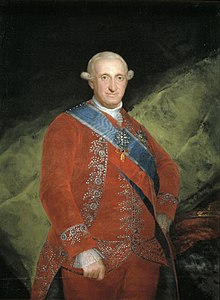
Back Carlos IV d'Espanya AN كارلوس الرابع Arabic كارلوس الرابع ملك اسبانيا ARZ Carlos IV d'España AST IV Karl (İspaniya kralı) Azerbaijani دؤردونجو کارلوس (ایسپانیا) AZB Карл IV (кароль Іспаніі) Byelorussian Карлос IV Bulgarian Carlos IV Breton Karlo IV, kralj Španije BS
| Charles IV | |||||
|---|---|---|---|---|---|
 Portrait by Francisco Goya, 1789 | |||||
| King of Spain | |||||
| Reign | 14 December 1788 – 19 March 1808 | ||||
| Predecessor | Charles III | ||||
| Successor | Ferdinand VII | ||||
| Chief ministers | See list
| ||||
| Born | 11 November 1748 Palace of Portici, Portici, Naples | ||||
| Died | 20 January 1819 (aged 70) Palazzo Barberini, Rome, Papal States | ||||
| Burial | |||||
| Spouse | |||||
| Issue | |||||
| |||||
| House | Bourbon | ||||
| Father | Charles III of Spain | ||||
| Mother | Maria Amalia of Saxony | ||||
| Religion | Catholic Church | ||||
| Signature |  | ||||
Charles IV (Spanish: Carlos Antonio Pascual Francisco Javier Juan Nepomuceno José Januario Serafín Diego de Borbón y Sajonia; 11 November 1748 – 20 January 1819) was King of Spain and ruler of the Spanish Empire from 1788 to 1808.
The Spain inherited by Charles IV gave few indications of instability,[1] but during his reign, Spain entered a series of disadvantageous alliances and his regime constantly sought cash to deal with the exigencies of war. He detested his son and heir Ferdinand, who led the unsuccessful El Escorial Conspiracy and later forced Charles's abdication after the Tumult of Aranjuez in March 1808, along with the ouster of his widely hated first minister Manuel de Godoy. Summoned to Bayonne by Napoleon Bonaparte, who forced Ferdinand VII to abdicate, Charles IV also abdicated, paving the way for Napoleon to place his older brother Joseph Bonaparte on the throne of Spain. The reign of Charles IV turned out to be a major turning point in Spanish history.[2][3]
- ^ Lynch, John. Bourbon Spain, 1700–1808. Basil Blackwell 1989, p. 375
- ^ Lynch, "Charles IV and the Crisis of Bourbon Spain", Chapter 10, Bourbon Spain.
- ^ "Charles IV of Spain and His Family hides a rulers caricature". Hypercritic. Retrieved 19 March 2023.
© MMXXIII Rich X Search. We shall prevail. All rights reserved. Rich X Search